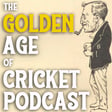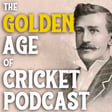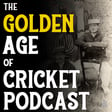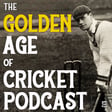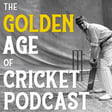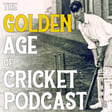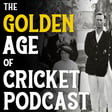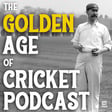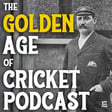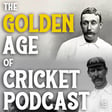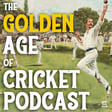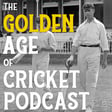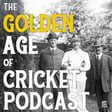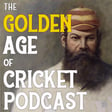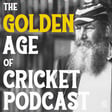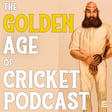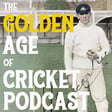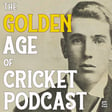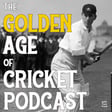Introduction to the Golden Age of Cricket Podcast
00:00:09
Speaker
and welcome to this episode of the Golden Age of Cricket Podcast, a series where we explore the lives, careers and statistics of those cricketers who flourished during the quarter century before the First World War. My name is Tom Ford.
Impact of WWI on Cricket and Players
00:00:35
Speaker
outbreak of the war in 1914 drew a curtain on competitive international cricket, and very much closed the window on what had been a sparkling period for the sport, a period of unprecedented performance, press coverage and character. Many first-class cricketers signed up to the war effort and never returned, or for some were left with crippling career-ending injuries.
00:00:59
Speaker
A number of Golden
Post-War Cricket Careers Resumed
00:01:00
Speaker
Age cricketers were lucky enough to play international cricket after the war, most famously Warwick Armstrong, Wilford Rhodes, Warren Bardsley and Jack Hobbs. One member,
Spotlight on Charlie McCartney's Early Career
00:01:11
Speaker
perhaps best remembered today for his swashbuckling batting feats in the 1920's was Charlie McCartney, who first shone as a dashing, confident, young all-rounder during the Edwardian period, and it's this early part of his career which is the subject of today's podcast.
Interview with Peter Lloyd on McCartney's Biography
00:01:30
Speaker
welcome my first ever returning guest. Having helped me launch the podcast when he discussed his then freshly written biography on Monty Noble, Peter Lloyd has now produced an equally informative and well researched book on McCartney titled, Charlie McCartney, Mayhem and Artistry.
00:01:49
Speaker
Of particular note is his focus on many areas of McCartney's life which previous biographers have either missed or chosen to avoid, and to which I look forward to discussing with him in the course of our chat. Peter, welcome back to the podcast.
Challenges in Writing Cricket Biographies
00:02:05
Speaker
you, Tom. um It's a pleasure to be here and I appreciate the fact that I'm your first returning guest. um I may have been your first original guinea pig, but some of your subsequent guests have been ever so eloquent and informative about their own works. Little wonder that your series was acknowledged in the award season in your first year.
00:02:28
Speaker
What a smorgasbord of great golden ages you've already got in the can, so to speak. I'd really encourage those listeners um who haven't done so already to tipp back and have a look at your um back numbers, so to speak.
00:02:42
Speaker
Thank you, Peter. That's very kind
Critique of Previous McCartney Biographies
00:02:44
Speaker
of you. And ah like I said, it's very nice to have you back and to be turning our attention to another one of your ah subjects, like I said. um Now this is, it's not the first biography ever written on Charlie McCartney.
00:03:01
Speaker
um So as a biographer, were you confident going into the research process that you would have something new to say or did that become apparent after the research began?
00:03:15
Speaker
When I wrote my first Golden Age biography on Warren Bardsley back in 2021, I pointed out a time that his cricketing deeds, let alone his life had never been addressed in any longer form essay, despite his undoubted sporting calibre. Many of
Approach to Research and Biography Writing
00:03:32
Speaker
his contemporaries had been the subject of some distinguished authors, but I knew from the get-go that Charlie McCartney's story had been poorly managed by his first biographer in 2004.
00:03:45
Speaker
It was a rather shallow, narrow and at times prefabricated account. Totally unfulfilling and inadequate and I knew that Charlie deserved more. I'm sure you'll appreciate this, Tom, and agree. ah Rigorous research is part of the fun of the exercise of discovery and exposition. Scholarly inquiry entails finding primary evidence of some description or another, and ideally being able to point to at least two substantiating sources for further confirmation. My particular style of writing, not like by everyone I admit,
00:04:20
Speaker
is to provide the reader with immediate access to sources I've used to stake a claim. ah Footnotes, I think, are far superior to endnotes. Sometimes they point the reader to an important source. Other times they suggest an extension to the primary focus that isn't part of the main game but still of interest. So it can be very frustrating when an author makes sweeping statements about a particular incident or behavioural characteristic without any attempt to support their contention.
Insights from McCartney's Personal Archives
00:04:50
Speaker
So, for example, and without wanting to disparage the work of the late Greg Groudon, he was a fine writer and an excellent recorder and and and analyst. um Greg did suggest that McCartney's state of mental health was damaged by his experiences at the front during the Great War. I happen to agree with what he wrote in his award-winning 2019 book, Quicklers at War, about Charlie's war neuroses.
00:05:15
Speaker
But Greg provided nothing in the way of documentary evidence to support his claims. Yeah. And um we're going to touch on McCartney's battles with mental health shortly in the podcast. um But Peter, as you write in your book, ah McCartney's own autobiography, which was titled My Cricutting Days, ah provides very little in the way of personal information.
00:05:44
Speaker
um So again, as a biographer, what difficulties did you have to overcome in relation to the availability of resources? yeah ah Charlie's own account of his cricketing life was carefully constructed and chummy. ah Perhaps it was crafted in tandem with his very astute and classically educated wife Nan. It was understandably far from revelationary about his inner self. It wasn't really an autobiography. I believed and so proved that there was much more to uncover about the Governor General both on and off the field. However, I never set out to write a behemoth of a book. I'm sure that there are
00:06:23
Speaker
Very few cricketing terms about one individual of over 700 pages in length. In modern times I can think of just two, ah Steve Warren, Ricky Ponting's autobiography. But those two, especially Ricky's, didn't reveal very much personal detail. I guess the the bottom line is that Charlie wouldn't let me off easily.
00:06:46
Speaker
andly Initially, he was unwilling to share, ah but after 12 months of intimacy, so to speak, he knew that this was likely to be his last chance to not, if not so set the record straight, at least to reveal a lot about the less well-known aspects of his life beyond cricket. Plus, he seemed to be telling me that he was keen to have his aggressive approach to cricket with both bat and ball, ah brought to the attention of modern fans of the game.
00:07:13
Speaker
His many meritorious deeds in the middle have been largely forgotten over the decades. Charlie was far from a vain person, but he championed the notion of always taking the game to the opposition.
00:07:27
Speaker
And I just have to add, ah Peter, because you mentioned it there in your answer that ah for anyone coming to Charlie McCartney for the first time, the Governor General was his nickname. ah We are not referring to some high office here. I'm hoping that in the course of this discussion, you might perhaps ah explain where that nickname comes from, michelle because it has ah has ah been his nickname ever since basically from his playing days and people still, as you did refer to him, such. um Peter, in terms of research, were there any descendants of McCartney who were able to assist you ah in the research for your book? Charlie married later in life and to an older woman. They didn't have any children. But as Nan, his wife was always saying they had a lot of fun together, travelling, socialising, watching cricket and playing golf and amongst other activities.
00:08:27
Speaker
Charlie's elder brother Harold um also remained childless as did younger sibling Clara who never married and who died in 1983 at the age of 94.
00:08:38
Speaker
um There are very distant descendants of Charlie's mother, Mary Ann Moore, daughter of the renowned colonial cricketer, George Moore, a bit more of him later perhaps, who are still living in New South Wales' Hunter region, that is in the Newcastle and surrounding areas, but none of them with any genuine link, close link to Charlie. um and Not in 1994 when the Hunter District Cricket Association acknowledged McCartney as a Hunter Hall of Famer,
00:09:08
Speaker
The award was accepted by a local cricket identity and regional historian, Lindsay Wood, who's written one of the two forwards to this biography. I was fortunate to have access through Cricket New South Wales Library to several of McCartney's scrapbook albums, which he alone, and then later in tandem with his wife, maintained throughout his long career. There were many items in one of the albums in particular, which opened up interesting avenues and inquiry beyond cricket.
00:09:37
Speaker
ah After I'd finished writing the book, I had a series of email kind correspondence conversations, I should say, with David Frith in England. David had read about the biography in an issue of the Cricket Memorial Society Journal, and he was keen for me to to know that when he was ah a young lad living in Sydney, he'd been introduced to Charlie at Burdole Fields Sports Depot on Hunter Street in the city. He described Charlie as being very reserved,
00:10:05
Speaker
Much later, in the 1970s, it visited Clara um at Belton, the old family home in on Sydney's lower north shore. she She was a charming petite woman, according to David, fully alert in her late 80s at the time, and she had much to relate about family matters. As David was leaving, she gave him Charlie's 1909 Ashes Tour album. I would love to have had access to that source. Anyway, I sent David a ah copy of the book, and he's currently writing a review of it
00:10:39
Speaker
for the cricketer magazine, which I'm looking forward to receiving in due course. Yeah, very nice. And I know many of ah my listeners will, of course, know the preeminence of David's writing and where he sits in. He sits right at the pinnacle. He does sit right at the pinnacle and we're very lucky to
McCartney's Cricket Journey Pre-and Post-WWI
00:10:59
Speaker
have him. um Now, Peter, um as I mentioned in at the top of this podcast, Charlie is one of a handful of international cricketers who transcended the First World War. That is, he played for his country both before and after. um Like many fans, I first came to know Charlie McCartney's um cricketing feats from after the First World War when he was an
00:11:29
Speaker
elder statesman and ah records. Well, I remember reading about his famous 170 against England, I think in 1920-21, which was ah made even more famous when Don Bradman referenced that innings as ah he was in the crowd that day as a 12-year-old and I think inspired him to pursue cricket. um But in many ways, Charlie McCartney's pre-war career, and that is that falls within the so-called Golden Age, ah is somewhat overlooked. Is that a is that a fair claim?
00:12:14
Speaker
I think it certainly is a factor. um I mean, I see what you're getting at this podcast series is all about the golden age. So um there's absolutely no doubt that McCartney was the world's preeminent cricketer in the early to mid 1920s. His evolution to that exalted status has been poorly described. I've gone to great lengths in the book to promote the view that his emergence as a stellar cricketer was a combination of innate talent and a lot of genuine hard yakka. Perhaps a recap to explain. ah Charlie was definitely a teenage prodigy when he first ah made his first class taboo in November 1905 in Brisbane at the age of 19. And then his test taboo in the Asher series in December, 1907.
00:13:05
Speaker
Initially, he was selected for both New South Wales and Australia as a bowling all-rounder. During the 07-08 series, which Australia won four matches to one, he batted in all 10 Australian innings, up and down the order, opening on three occasions, and first dropped twice, then at numbers five, six, seven, and eight. His average of 27.3 seems fairly pedestrian, but he had a hand in several important partnerships.
00:13:32
Speaker
The series was dominated by the boulders, Jack Crawford, Arthur Fielder and Sydney Barnes for England and Jack Saunders in particular for Australia. Owning Englishman George Gunn averaged more than 50 in the series. Charlie chipped in with 10 wickets and a shave over 26 runs per wicket. Arthur Jones's side saw plenty of Charlie during this tour. Apart from playing at all five tests, he met them on the field for New South Wales on two other occasions and for an Australian 11 in Brisbane immediately before the first test. I'm sure you're aware, Tom, as would be many of your listeners, that it was Kenneth Hutchings, the outstanding Kent amateur batsman, who was killed in the Great War at the age of 34, who first labelled McCartney the Governor General during the series. I think the tag was created not only because of Charlie's swagger with the bat,
00:14:27
Speaker
And he played four aggressive half-century innings in the seven matches against England or the MCC during that tour. But also because of his ability to impose himself at the bowl increase with his controlled line and length. And also in the field, close to the bat on the offside, he had a very strong arm and an accurate throw. In short, he was always in the game. ah But this was an especially strong Australian 11. Trumpet Hill, Noble, Armstrong, Cotter and Saunders.
00:14:57
Speaker
They were all dominant at different stages of the series. But nevertheless, Charlie was a solid contributor. Despite his performances in 1907-08, he didn't consider himself a certainty for the tour of England in 1909. But of course, Monty Noble, who wasn't a test selector, but who was still enormously influential, would never have allowed the squad to leave Australian shores without Charlie being a member of the party.
00:15:26
Speaker
In England, in 1909, McCartney had a ah modest batting tour record coming in down the order. It took him a good while to acclimatise to foreign conditions, ah despite practising on a waterlogged pitch in Victor Trump's backyard at Gordon. Charlie did post two excellent half centuries in the fourth and fifth tests during the 1909 tour, as his appreciation of how to handle sticky or slow English wickets improved.
00:15:54
Speaker
With the ball, two inspired spells of bowling, seven for 58 and four for 27, on a conducive pitch, virtually won Australia the vital third test at Leeds when the series was even at one apiece going into that match. Sydney Pardon, in wisdom, ah made much of Charlie's control and guile. Noble knew his worth and managed his workload astutely.
00:16:18
Speaker
unlike Sig Gregory, during the triangular tour of 1912, who really over bowled Charlie. um And of course, beyond all of that, his fielding was always inspirational. And then in 1910-11, McCartney had a series of low scores in the first three tests against the visiting South Africans, 15 runs coming in five innings, and he was dropped for the first time in his career for the fourth test.
00:16:45
Speaker
He regained his form. ah Charlie described it rather as breaking his run of bad luck ah with two sparkling sentries for the state against the tourists, which forced the selectors to recall him. So he rewarded them and everybody looking on when he hammered his maiden test out at Sydney, chancellors 137 in 193 minutes with 16 fours. Thank you, Tom Webster. um Charlie was surprisingly not picked for the first four tests of 1911-12 against Plum Warner's Victoria side. He was 12th man for the first three tests. He played in the fifth test only after Clem Hill, who had been supportive of his inclusion from the start and influential others, finally convinced New South Wales selector Frank Iredale and Victorian selector Peter McAllister to call him up.
00:17:38
Speaker
McCartney was discombobulated, if you like, by his omission, and he justifiably considered that the majority of the panel favoured players who had remained loyal to the Board of Control during the power struggle within Australian cricket. The wrangling of the of the big six matter made Australia's task of competing against um England more more ah difficult than it needed to be.
00:18:04
Speaker
There was just the one more international program for Australia before the First World War with the 1912 three-pronged triangular tournament. McCartney and Warren Bardsley were Australia's outstanding performers across the tournament.
00:18:19
Speaker
So ah Charlie was pleased with his efforts, and if I could quote from his autobiography, which, with due respect, focuses almost completely on on his cricketing activities, very little to do with ah things off out of off the field. So he says, that year, 1912, ended my run of bad luck.
00:18:44
Speaker
And I was never in doubt again regarding my position in a test side right up to the end of my career. I made over 2000 runs for that tour, finishing second to Warren Bardsley in the batting and leading with the averages for the bowling with about 50 wickets. I was not called on to bowl for some time after the tour commenced, but I went into an injury to Bill Whitty. Sid Gregory asked me to take a turn now and again.
00:19:09
Speaker
um Looking at statistics, ah at this point in his career in the pre-Great War era, Charlie batted on 34 occasions without a knockout score for 879 runs. I know you're quite keen on ensuring that statistics get a look in when we're in your chats. His average was 25.85 with a high score that of the 137 against South Africa and Sydney.
00:19:40
Speaker
and not in 1910 or 11. That was his sole test time to date, ah while he had six half-centuries to his name, including 99 at Lord's versus England in 1912, an innings which his dismissal still ah has a degree of controversy about it.
00:20:01
Speaker
After the resumption of Test cricket in 19 2021, he batted in a further 21 innings compared to the 34 before the war. um With the four not at scores for a total of 1252 runs at an average of 73.65, almost Batman like. And with the highest score of 170, the one you mentioned earlier, against England and Sydney. ah That was an innings for all to help behold, as ah you suggested, it energised on Redmond. So in the post-war First World War period, he scored a further six test centuries and three half centuries with a conversion rate that was significantly superior to that which occurred in his pre-war career.
00:20:47
Speaker
So to answer your Tom, ah sorry if I was a bit long winded, but Charlie's performances during the first phase of his top flight career were mixed. He was inconsistent with the bat, but he was up against several very fine bowlers. By 1912, I think it hit his straps and hadn't had it not been for the war of divining, he would have ensured his international reputation much earlier than he did.
00:21:12
Speaker
Yeah, fascinating. Thank you, Peter. And um I'm really glad that you've broken down his pre-war and post-war statistics like that. As you mentioned, we will be looking at his overall statistics later in the podcast. And um I think for someone like ah Charlie McCartney, it is important to separate the two periods um ah because as you've already alluded, you know, at the beginning he was very much an all-rounder and he was used in various ways and he was in and out of the side. Compared to post-war where he very much was ah the almost the doyen of the Australian cricket side and he's found a lot more consistency with his ah with his batting in particular. So
McCartney's Personal Struggles and Their Impact
00:21:59
Speaker
um we'll talk more about his career, ah about his statistics later on in the chat.
00:22:05
Speaker
um But it might be worth now ah turning our attention to his actual life and his early life. I actually want to begin talking about his mental health, which we've already referenced in this chat. And it's something which you've given quite a bit of attention to in your book.
00:22:27
Speaker
um He had four separate periods away from cricket during his career, um which owing to the time and the age wasn't fully explained at the time. So can you take us through how you made the link with these periods away from cricket with his mental health?
00:22:48
Speaker
um Yeah, mental health um is certainly at the core of bio my account of McCartney's life, including its impact on his cricketing career. I've estimated, and this doesn't include the last war years, that Charlie missed out on playing in over 50 top flight cricket ah matches due to his inherent mental health condition, which I consider as best described as an extreme example of anxiety disorder. His four lengthy periods of absence from the crease are going to be addressed individually I think as the podcast proceeds so I won't go into the particulars here but just to say though that while his experience of war exacerbated his mental health frailties these were very apparent as early as 1909.
00:23:53
Speaker
So Charlie McCartney was born in Maitland, New South Wales in June 1886. And
Influence of the Moore Family on McCartney
00:24:01
Speaker
the Moore side of the family, that is his mother's side, um had a very strong connection to cricket, which included a couple of Charlie's ancestors even playing against an all England side in the 1860s. Peter, what can you tell us about Charlie's cricketing pedigree?
00:24:22
Speaker
So I emphasize throughout the book how the Moore family linkage played a significant part in formulating and fermenting Charlie's love of cricket. Grandfather George Moore and great uncle Jimmy Moore, ah James, Jimmy, Jimmy Moore, both played organized cricket in Bedfordshire, England before migrating separately to Australia in the mid 19th century and then established themselves in the thriving commercial township of Maitland ah in the Hunter region of New South Wales. At that point, Maclin was perhaps the second most vigorous commercial centre in New South Wales ah behind Only Sydney. The skills that and the knowledge of cricket ah that they brought to the township and to the area of the district lifted the standard of sport ah cricket ah to the point where the combined local side was at least the equal of several visiting teams from the Big Smoke.
00:25:21
Speaker
where the sport was taken very seriously indeed. One such 11 was the Redfern-based Albert Club, regarded widely as the pace setters in Sydney Club cricket.
00:25:32
Speaker
Both George and Jimmy went on to play, as you say, for New South Wales colonial sides, often comprising 18 or 22 players, against several visiting teams from the mother country. ah So I'm talking about H.H. Stevenson's 11 of 1862, George Parr's side of 1863-64, and W.G. Grace's team in 1873-74. As well, they played in several inter-colonial matches for New South Wales against Victoria.
00:26:02
Speaker
Two of Jimmy's sons, Leon and William, also played first-class cricket for New South Wales. William also represented Western Australia. George played his final first-class match at Sydney's Albert ground at the age of 53. So I was also keen to establish whether Charlie's father, Joseph Belton McCartney, JB McCartney, played cricket at some level. um With the help of Lindsay Wood, I mentioned before, ah we were able to find just two references to JB in the local newspaper, of the Maitland Mercury, which by the way is an excellent resource for early sporting and artistic doings in the ah Hunter area. It was a model of a newspaper that um many other regional areas
00:26:50
Speaker
could look up to with with a great deal of pride, I guess. We were able to find
McCartney's Early Cricket Development in Sydney
00:26:57
Speaker
that JB played social cricket, but only twice. And one of those occasions he played alongside his father-in-law, George, ah but without any great distinction. So um there was a solid vein of gold, if you like,
00:27:18
Speaker
ah in the heritage from his mother's side of the family. Yes, um predominantly in the Moor side, that's M-O-O-R-E. um But despite, well not despite, perhaps um because of that strong upbringing, it gives him this tremendous foundation in the skills and art of playing cricket. um But then in 1898, so when Charlie is age 12, the McCartney family leave Maitland and they head to the Big Smoke in Sydney. um What impact did this have on Charlie, um both socially but perhaps more pertinently to this podcast to his cricketing development?
00:28:08
Speaker
So there was no organised junior cricket in Maitland and Jalab to the JB McCartney's left the rural hub settling in Sydney's inner eastern suburb of Wallara. There was a lot of green space for playing all sorts of games then as now and for wagging school in the process. Charlie played school cricket for Wallara Superior Public School and later for 4th Street Model School.
00:28:32
Speaker
However, the particulars of his early schoolboy deeds on the field are ah scant. He also played for a congregational church social side in a Saturday afternoon Queens Park open age competition. ah He was short in statue, but with unbounded enthusiasm. And I asked rhetorically in the biography whether any of his adult teammates ah in the church side may have recognized him as his elite career unfolded.
00:29:01
Speaker
For that, for many of them, it would likely have been their closest connection to cricketing royalty. Yeah. um And his development continued on. So three years after ah the family moved to Sydney, Woulara, as you say, which is in the sort of southeastern suburbs of Sydney, the family again moved this time in 1901 to the North Shore suburb of Chatswood.
00:29:31
Speaker
um And if anyone does know Sydney, Wallara to Chatswood is not a short distance and certainly not in 1901, it would have been even further. um What specifically happened to Charlie's cricket form ah upon moving to Chatswood? um So the move to Chatswood was a commercial decision by JB McCardney, who in his entrepreneurial manner, he was a very ah savvy businessman, he saw opportunities to grow his myriad of businesses in a sparsely developed area of the sprawling metropolis. But for Charlie, it meant a new school and proximity to what would become the epicentre of his entire quickening life, Chatswood Oval, a ground that would witness many of his outstanding, occasionally outlandish performances, but far different in the early 20th century than what it would become in a relatively few short years.
00:30:28
Speaker
At school, McCartney continued to prefer games to classroom instruction, and he performed well enough to provoke some attention from the press, and at the same time, he caught the eye of Monte Noble, but his schooling days were soon over.
00:30:44
Speaker
And I have to jump in there Peter and say that until a short time ago I would catch the train every day to work and pass Chatswood Oval and the train goes over just past the oval and it's a very pretty ah looking field in an otherwise pretty bland trip into the city. I would always i would always look down on that cricketing field and wonder um at the legends, and we might touch on them later, ah those who have also played on that field. It's very famous ground on the North Shore. So that the route, the train line ran at exactly the same as the one now, except of course, um steam engines rather than the electric electric trains. I think the journey was quite quite pleasant, but not so much because of, I think in the early part of the 20th century, some of the best laborious aspects of urbanization hadn't yet encroached, so a lot of bushland between stations.
00:31:50
Speaker
Well, and now you've got the um recently launched Metro, which leaves Chatswood and goes underground at some huge speed and you completely bypass the oval. So if you're wanting to see, if you're wanting to see the oval, catch the train, the old traditional train into the city and you'll get this beautiful view of the, of the ground. um Anyway, we digress. um So Peter in 1902, 03, we're heading ah now towards his ah late teenage years. He makes his debut for the club North Sydney. um And he takes ah no wickets for 14 runs, bowling his slow left arm spin. And he bats at number 11, and he makes 12 runs. um At this point in time, can you tell us, was he primarily a bowler or a batsman? um Or possibly both?
00:32:51
Speaker
So Charlie took great pride in noting that he never played any form of junior cricket at all. When he was 16, having left school, he worked as a clerk for a shipping company at the Sussex Street Docks in the bustling heart of Sydney CBD. And he joined the North Sydney District Club in 1902-03, as you say, because he was required to do that if he wanted to play grade cricket, given the Sydney electoral qualification rules introduced in 1893-94. Members of the North Sydney Club um were were and remain known as the Shawmen due to the closeness of the North Sydney Oval to the harbour. At that time, ah North Sydney was the only great club on the north side of Sydney Harbour. Two seasons in the lower grades at a club with a solid pool of first-class cricketers saw him on his way. By the end of the 1900-405 season,
00:33:48
Speaker
He was a regular member of the first grade 11, which won the premiership that year in a counter. So he saw himself as an all rounder. I think the selectors at North Sydney also noticed that he had capabilities with both bat and ball, as well as his fielding attributes, which were phenomenal.
00:34:14
Speaker
And it's interesting, I mean, McCartney is just another one of a group of golden ages, if we can term them as such, whom today we look on as batsmen or bowlers, but primarily as batsmen. And we completely forget that they also bowled. I mean, Trump was another one who was ah quite a fine bowler, but all we hear about these days with Victor is his batting Gilbert Jessup was another one he was a bowler but we we only hear about his rather rapid batting style so McCartney certainly at this point in time and well into the yeah the start of his career very much was um a batting and bowling all-rounder
00:35:01
Speaker
it was the and He opened the batting and the bowling for for Gordon um as as the as the club ah evolved most weekends and successfully. Yes.
McCartney's Career with Gordon Cricket Club
00:35:14
Speaker
um So Peter, the the the progressive expansion of electoral cricket in Sydney, which had begun in the 1893-94 season, saw the birth of the Gordon Cricket Club in 1905-06.
00:35:29
Speaker
um And this was somewhat unusual in that the club did not have to prove its calibre through sustained performances at lower grade level to gain entry to the competition. um Charlie qualified for the newly formed club ah and he bowled their very first ball in fact and took their very first wicket. This is for the Gordon Cricket Club.
00:35:54
Speaker
um And it was the beginning of a very, very long and successful career for the club. um this what what What can you tell us about his long association with with Gordon Cricket Club?
00:36:10
Speaker
ah So Gordon um was one of two clubs introduced to Sydney first grade competition in 1905, 106. With McCartney's home, you know, Tauman being smack bang in the middle of Gordon Gordon's catchment area. Charlie with a few other senior North Sydney players.
00:36:29
Speaker
was obliged to to change allegiances and that's where he would remain for the next 22 seasons. During the Great War the competition was suspended for three years and his last season of Great Cricket was 1933-34.
00:36:45
Speaker
um and I know we'll will touch on Gordon again throughout the course of this discussion because it was one of the great constants in his life. um Now it might be appropriate at this point in time Peter to actually, ah to the best of your ability, describe ah Charlie's batting and bowling style. We've already ah mentioned I think when he first started bowling he was bowling slow left arm spin but how would you describe both his batting and his bowling styles to a modern audience?
00:37:23
Speaker
um Looking at his batting first perhaps in his early lower tier and representative years he was a fairly orthodox batsman notwithstanding the fact that he had an enormous first pace towards the ball which would be a hallmark of his entire career. Many people marveled at how he could maintain his balance. ah What cinema footage exists, and in the book I show readers how to access that, it was a remarkable feat. He also quickly mastered the art of moving across the crease to the off to manoeuvre balls to wherever he chose. His hand-eye coordination was incredible. He could pick up the length of the ball and a twinkle.
00:38:04
Speaker
A bit like the Indian wicket keeper, Pants, he seems to have, watching him yesterday play, he had a lot more time ah facing extremely good bowling than his colleagues. And Charlie was in the same mould. As far as bowling was concerned, he was extremely economical. ah He learned a lot from his grandfather, George Moore,
00:38:34
Speaker
and He also learned a lot from observing Hugh Trumbull in the 1902 series. he learnt how to be he learn what controlled bowling was really about. He had a cleverly disguised faster ball. You're right in saying that he bowled slow, ah but but there were occasions when he bowled more of a slow medium ah ball which reached the batsman before they were through with their stroke. ah he could do He could make the ball
00:39:07
Speaker
that he could propel the ball more rapidly without changing his style, without changing his arm motion. So at grade level, he was lethal, regardless of the pitch conditions. At representative level, ah confronted by more capable batsmen, he'd needed conducive pitch and atmospheric conditions to help him gain an advantage. However, his control of line and length was always impeccable.
00:39:33
Speaker
and he often amazed critics at how he could contain even the most dashing of batsmen. Some of the English ah more aggressive batsmen, and I'm thinking of C.B. Frye and Jessup, Charlie could could maintain a line of length which caused them to struggle to be too aggressive against him.
00:39:59
Speaker
I appreciate your ah comparison of his batting with India's Pant um for modern listeners. Is there a modern bowler you could compare him to or is that hard considering it's a sort of a style of bowling from a hundred years ago which possibly doesn't exist now?
00:40:22
Speaker
um Being a left-handed bowler, um I'd say that perhaps Dejaja from mean India also, he's in the ah in the eye at the moment of course, similar in his capacity to be able to land a ball on a handkerchief as the common description goes these days. Dejaja I think doesn't turn the ball ah significantly but it's his line and length a nagging accuracy that causes some havoc with batting. And I think Charlie
McCartney's Rise to International Cricket
00:40:58
Speaker
had that same approach. Charlie would be probably a lesser baller than to change it, but a much more vigorous batsman. But both football rounders definitely.
00:41:20
Speaker
I'll be Johnny on the spot firing out the winning shot. Now, Danny, want to go.
00:41:30
Speaker
So back to his development as ah as a young cricketer, he makes his first class debut against Queensland in November of 1905 and he hits 56 batting at number 8 and not too long after that he then makes his Sheffield Shield debut um in December so a month later playing against South Australia at the Adelaide Oval and in this match he strikes 17 not out batting at number seven. So again can I ask was he selected for these matches as a bowler or batsman or both?
00:42:12
Speaker
I think he was fundamentally um a bowling all-rounder. I don't think he was too fussed about how he was actually perceived by selectors. He just lowered all aspect of play and was eager to perform to help his team's cause. So he didn't mind being pushed up and down the order. ah I think he felt that the better captains could appreciate the fact that he would be able to offer some substance with both bat and ball um and was quite happy to be uh manipulated around on the crease in the crease uh batting crease and uh on the bowling crease um yeah um and again it's sort of becoming apparent that he's having this fairly rapid rise so shortly after again he he makes his uh debut in his first international match in a
00:43:04
Speaker
what's described as a semi-test it's not a formal test match um again in Queensland against the touring English of the 1907-08 season and this time he opens the batting ah which I think was the first time ever um and it's under the leadership of Peter McAllister someone who's already been mentioned and will be mentioned again no doubt later in the podcast. So how did he how did he perform in this semi-test?
00:43:35
Speaker
I hadn't actually um made that distinction between ah the two home and a away ah matches he played for New South Wales against the MCC immediately prior to the Australian 11 match at the Gabba in early December 1907. I'm quite sure that's technically correct but it's an interesting matter and I think Ray Webster certainly classifies the game at just as just another first-class fixture, although he does refer to the semi-test character of the encounter.
00:44:02
Speaker
in line with contemporary newspaper reports. Regardless, ah Charlie was on show and batting in front of Victorian selector McAllister. He batted with a great deal of freedom, hitting 42 uneven time with fourf four fours against tight bowling before being brought in bowl by a slow medium leg spinner, Lynne Brown, who achieved the figures of seven for 117 off 22 point four but point five over Charlie was then given 16 overs after three others had been tried and finished with the best figures of four for 36 with six maidens. His victims were Joe Hardstaff Jr., Bronn, Wilfrid Rhodes, all very capable batsmen and all being bold, and Colin Blythe.
00:44:48
Speaker
The three-day match was washed out, but Charlie had certainly done enough to ensure selection in the first test side a week later. And yes, he is selected in that first test match of the 1907-08 series um and is very much utilized as an all-rounder.
00:45:07
Speaker
um hes His debut was described ah by ah one newspaper as highly credible and it was a too wicked victory to Australia. How do you assess his official international debut?
00:45:24
Speaker
um So the first test of the 07-08 series was indeed in the firmament for five days of play. At the end of the match, Tibby Carter was the standout performer with bat and ball. However, the indefatigual fast right armour Arthur Fielder bowled magnificently in both Australian innings, taking six for 82 and three for 88 with very tight overs. He had all the batsmen at sea with his off cutters and out swingers, even first innings top scorer, Clem Hill. I'm sure that'll impress you, Tom.
00:45:59
Speaker
But Arthur was still bowling express place when Charlie came to the wicket at the fall of the fifth wicket on the second day with a score on 184 in reply to England's total of 273. When he joined Vernon Ransford, also on Dubu, he looked a class act, unlike the earlier batsmen. And I quote here from ah there the journalist known as Recorder.
00:46:27
Speaker
I wish I knew of his real name. The pseudonym is Abt. He had a very good eye to the history of the noble game, a little like Jack Davis of the referee and arrow. um He wrote in the Sydney Sports Sportsman newspaper and on the 18th of December 1907 he claim that, unlike most of his comrades, McCartney has a splendid method of coping with the off theory. Instead of maintaining his primary stance at the wicket and reaching across for the ball, he takes a short step with his right leg, bringing the left up very quickly. He's thus enabled to get the full force of the ball or the bat on the ball,
00:47:11
Speaker
for he uses his left arm in a perfect manner, reminding one very much of the old writer's description of Silverbilly Beldam, probably the equal of W.G. Grace as a batsman, and certainly one of the greatest batsmen of his or any age. There were several journalists ah writing in the Sydney Press who had this historic bent who wanted to cast current players ah in the light in the light of a tradition of batting and um recorder was one such reporter um this he was a reporter who could look back at a passage with some pride uh because
00:47:56
Speaker
ah He captured something about McCartney that would become a feature of his career, of his entire career. um ah these these were These were Hallmark qualities of Charlie that Recorder ah noticed. um Charlie was out for 35.
00:48:16
Speaker
um when he fell for one of Fielder's entices and was caught behind by a wicket keeper, Dick Young. So, as you suggest Tom, this innings was summed up by the recorder as highly credible, with Charlie, and I quote again, displaying any amount of nerve.
00:48:33
Speaker
He then bowled 14 overs in England's second innings for figures of 1 for 39, his initial test victim being Wilfrid Rhodes, who was batting at the top of the order. Charlie was also applauded for his fielding, with his returns to the wicket being described as brilliant. All in all, a fine beginning to his test career.
00:48:53
Speaker
Yeah very much so and um he's really chosen a fantastic series to enter the international arena because it's these early matches are quite exciting with the second test match which head then heads down to Melbourne is equally if not of greater excitement. um This time England reverses the result with a one wicket victory after Hazlitt's missed throw at the stumps to tie the match, ah gives them the final result. um But again, what can you tell us about Charlie McCartney's contribution to this match? So a multimodal skipper chose to promote McCartney to open the Australian first innings with Trumper.
00:49:42
Speaker
That must have been such a thrill for the youngster. He and Vic combined in a forceful partnership of 84 in 81 minutes on the first morning before the senior man was caught at the wicket off Jack Crawford for 49. Charlie at that stage was 34 and not out um when they went to lunch and he added just three more before being bowled by Crawford for um for 37, which he compiled in 90 minutes, hitting just the one boundary. ah The Australian score of 266 was below par on a good wicket. England replied with 382, Hutchings scored a hundred ah brilliant 126. Conner Saunders did most of the bowling and took the bulk of the wickets. Charlie had 12 overs and conceded 34 runs without taking a wicket.
00:50:31
Speaker
In the second Australian innings, Noble took strike at the top of the order with Trump to good effect, the pair wiping out the deficit and putting on 126 for the first weekend. McCartney batting at number 6 did well again, scoring 54 in 147 minutes with 5-4s. It was described as a plucky and sound innings at a critical time. As you noted, ah with Australia posting 3-9-7, England scraped through the win the test by the single wicket with a final unbroken partnership of 39 between Barnes and Fielder.
00:51:04
Speaker
Charlie Bold, nine tide overs at sixth change for 21 runs and took the wicket of Hutchings caught by Cotter. I probably speak for maybe some listeners out there that if there was ever a chance to hop in a time machine and see a yeah one session of test cricket, I think watching Victor Trump and Charlie McCartney walk out to open the batting for Australia.
00:51:30
Speaker
would probably be up there at the at the Melbourne Cricket Ground. I think that would have been quite special. i wrote dead

